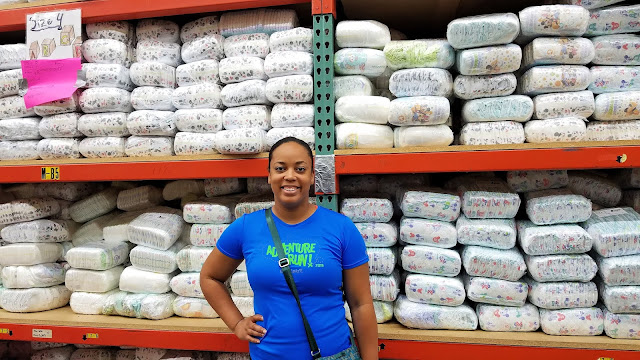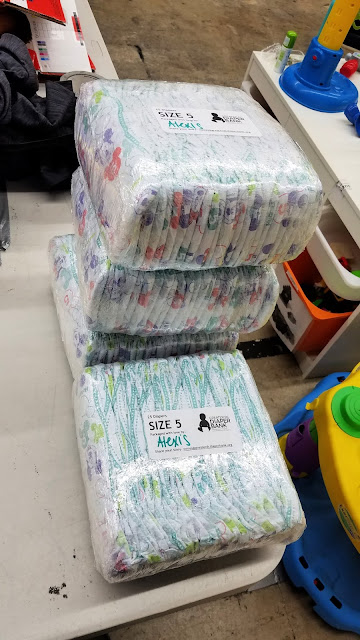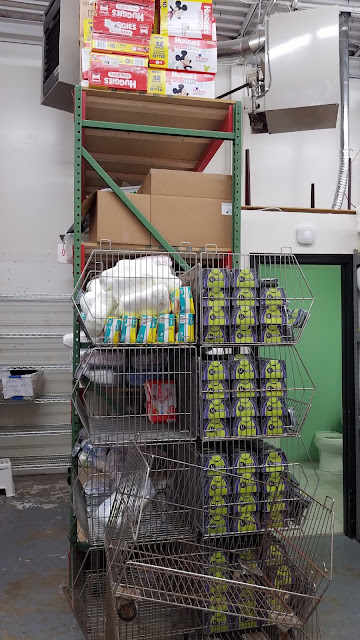Diaper Deserts and Period Poverty
For my volunteer time slot, I was tasked with packaging up diapers in groups of 25. Twenty-five seems like a nice number, right? Well, when it comes to diapers, apparently the answer is no. Some of the packs of diapers I unwrapped were in sleeves of 24, while others were in sets of odd numbers, like 17. Huh? There didn’t appear to be a standard number across brands or sizes, or anything really.
Did you know that newborns generally use about 8-10 diapers per day? So, a newborn could go through an entire pack of diapers in just 2 or 3 days. Many families buy memberships to certain stores so that they can get a good deal on diapers in bulk, but not all families can afford those memberships, or the transportation required to get the bulk items home. In fact, many low-income families live in communities where there are essentially diaper deserts – in a pinch, you can only buy diapers from a corner store, and you can often only buy them by the diaper. I can’t even begin to wrap my head around how much that would cost over time.
One DC Diaper Bank staff member shared a story with me about a social worker who comes to pick up packs of diapers from the Diaper Bank for their clients. This social worker shared that one of their clients had a daughter who was preschool aged and that she was going to school sporadically. When the mother was informed about the Diaper Bank, the child started attending school regularly. When asked what changed, the mother explained that, once she didn’t have to buy so many diapers, she could actually afford to spend that money on bus rides so she could bring her daughter to school every day. The staff at DC Diaper Bank used this story to illustrate their belief that the Diaper Bank is really just a gateway resource, in that families learn about the ability to obtain a certain amount of free diapers per month, and that opens them up to learning about other resources available.
This was also found to be the case with period supplies. Another member of their staff explained to me that they received a huge shipment of maxi pads and tampons from Kotex as part of the Alliance for Period Supplies fairly recently. Fun fact: U By Kotex is a founding sponsor of the Alliance for Period Supplies. The Alliance was founded in May of this year.
They had a male social worker who they suggested take some feminine hygiene products to the organization where he works, and to see if anyone took them. He only took a small amount because he said nobody had ever expressed this need to him, and when he returned on another trip, he shared that he ran out. So many women needed them! A shocking statistic from the Alliance for Period Supplies says that 1 in 4 women struggled to purchase period products within the past year due to lack of income. I heard a report about homeless women and their need for menstrual products and it was so shocking to me. (If you’re interested in reading more about the topic of period poverty, check out this article and this report by NPR.)
If you’re in the DC Metro Area, next week is Community Service Week in Montgomery County, Maryland. I highly recommend signing up to volunteer with the DC Diaper Bank. They are extremely organized, and could really use the extra support. Weekends tend to fill up pretty quickly, so if you have time during the week to help out, that’s your best bet. The cool thing about the DC Diaper Bank is that you can bring your kids to volunteer as well. There was a 4-year old who was in my volunteer group, and he was super helpful!
Have you ever heard about diaper deserts or period poverty? Have you ever volunteered at a diaper bank or allied program in your area?





